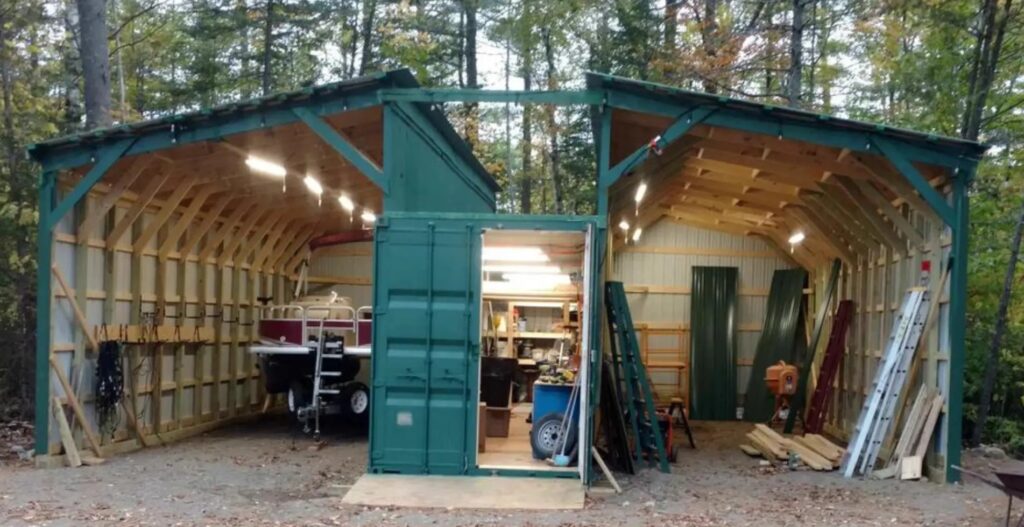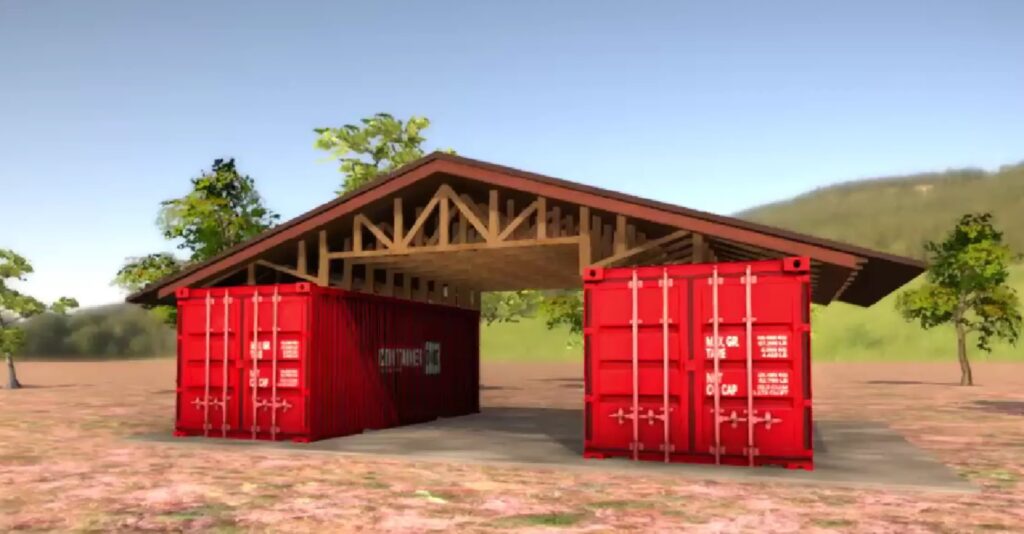Shipping Container Garage Storage
Is your garage flled with so much stuff that your car barely fits? Or do you park outside because you don’t have a garage?
You’re not alone. Storage space is a challenge for many Americans.
Exposing vehicles and other equipment to harsh weather can be costly. But with today’s high construction costs, building a garage is also expensive.
Just like many have built shipping container homes, some do-it-yourselfers are building shipping container garages. Using shipping containers to build a garage is cheaper, faster, and easier than building with traditional materials.
Shipping containers offer durable weatherproof storage without any modifications. You can create a great shipping container garage, carport, or shed easily, even if you have no construction experience.
Do Cars Fit In Shipping Containers?
The average midsize car is about 6 feet wide and 15 feet long. So, technically, most cars do fit into a single 20 ft shipping container which has a width of 8 feet.

However, the inside of shipping containers are only around 7 feet 8 inches wide. That doesn’t leave enough room to open the car door and get out once you’ve parked it in the container garage.
In the quest for innovative storage solutions, shipping containers have emerged as a popular choice. They offer a unique blend of durability, versatility, and affordability.
This article delves into the concept of shipping container garage storage. We’ll explore how these steel boxes can be transformed into functional, secure, and customizable garages.
The focus will be on various aspects of shipping container garages. From planning and building to storage solutions and maintenance, we’ll cover it all. We’ll also discuss the feasibility of two-story garages and the benefits of garage kits.
We want to offer a complete guide for homeowners and DIY fans interested in this new storage solution. We’ll also touch upon the legal aspects, such as zoning laws and building codes.
We’ll explore how to maximize space with wall and ceiling storage solutions. Plus, we’ll share some real-life examples and success stories from across the USA.
Whether you’re considering a shipping container garage or just curious about the concept, this article is for you. So, let’s dive in and explore the world of shipping container garage storage.
Understanding Shipping Container Garages
Shipping container garages are a creative and practical solution to storage needs. They involve repurposing shipping containers, typically used for transporting goods, into garages.
These garages can be customized to fit various needs. From a single car garage to a spacious workshop, the possibilities are endless.
What is a Shipping Container Garage?
A shipping container garage is essentially a garage made from a shipping container. These containers are made of steel, making them sturdy and durable.
They can be placed on your property and customized to serve as a secure space for your vehicles, tools, and equipment.
Benefits of Shipping Container Garages
Shipping container garages come with several benefits. They are cost-effective, as shipping containers are relatively cheaper than traditional garage construction materials.
Here are some key benefits:
- Durability: Shipping containers are designed to withstand harsh weather conditions, making them extremely durable.
- Security: Their sturdy construction makes them secure against break-ins.
- Customizability: They can be modified to fit your specific needs, including size, design, and interior layout.
- Eco-friendly: Repurposing shipping containers reduces waste and promotes recycling.
Common Concerns and Solutions
Despite the benefits, there are some concerns associated with shipping container garages. One common concern is condensation, which can lead to rust and damage to stored items.
However, this can be addressed by installing proper insulation and ventilation. Another concern is local zoning laws and building codes. It’s important to check with local authorities before installing a shipping container garage.
With the right planning and preparation, these concerns can be effectively managed, making shipping container garages a viable storage solution.
Planning Your Shipping Container Garage
Planning is a crucial step in setting up your shipping container garage. Choose the right container size, know local laws, and consider design options for customization.
Choosing the Right Container Size
The size of the shipping container you choose will depend on your specific needs. If you plan to store a single vehicle and a few tools, a 20-foot container may suffice.
However, if you need more space for multiple vehicles or a workshop, you might consider a 40-foot container. Remember, it’s better to have extra space than not enough.
Zoning Laws and Building Codes
Before you start setting up your shipping container garage, it’s important to understand local zoning laws and building codes. These regulations vary by location and can affect where and how you can install your garage.
For instance, some areas may require a certain distance between the garage and property lines. Others may have specific requirements for foundations or structural modifications. Always check with your local authorities to ensure compliance.
Design and Customization Options
Shipping container garages offer a wide range of design and customization options. You can choose to add doors, windows, and interior walls to suit your needs.
Here are some customization options to consider:
- Doors: Consider adding roll-up doors for easy access or a personal door for convenience.
- Windows: Windows can provide natural light and ventilation.
- Interior Walls: These can be added to create separate sections within the garage.
Remember, your shipping container garage should not only be functional but also aesthetically pleasing. Choose designs that complement your home and surroundings.
Building a Shipping Container Garage
Once you’ve planned your shipping container garage, the next step is to start building. This involves setting up a solid foundation, ensuring structural integrity, and considering insulation, ventilation, and climate control. You’ll also need to think about doors, windows, and accessibility.
Shipping Container Equipment Shop With Arch Roof

If you desire a more finished looking garage made from shipping containers, a gable roof design may fit you best. A gable roof garage is attractive and will blend into any suburban setting at the fraction of the cost as a stick-built garage.
The gable roof design uses two shipping containers for storage. It features a gable roof made from wooden trusses. Regular roofing materials are placed on top.
The size of the parking space between the containers is flexible. However, if you plan to use a standard sized garage door, your framing must be 9 feet wide. But a wider separation or container modifications are needed to comfortably park your vehicles inside.
Estimated DIY Cost To Build: $15K (two 20 ft containers with truss roof)
Foundation and Structural Integrity
The foundation of your shipping container garage is crucial for its stability and longevity. It ensures that the container is level and protects it from ground moisture.
Here are some foundation options to consider:
- Concrete slab: This is a popular choice due to its strength and durability.
- Piers: These are less invasive and can be a cost-effective option.
- Strip footing: This involves creating a continuous strip of concrete to support the container.
Remember, the foundation must be strong enough to support the weight of the container and its contents. It’s advisable to consult with a professional to ensure the foundation is correctly installed.
Insulation, Ventilation, and Climate Control
Insulation is essential for maintaining a comfortable temperature inside your shipping container garage. It also helps to prevent condensation, which can lead to rust and corrosion.
Here are some insulation options to consider:
- Spray foam: This provides a high level of insulation and is great for sealing gaps.
- Blanket insulation: This is a cost-effective option that’s easy to install.
- Panel insulation: This offers a balance between cost and performance.
Ventilation is also important to ensure a steady flow of air, which can help to prevent dampness and mold. Consider installing vents or an HVAC system for climate control.
Doors, Windows, and Accessibility
The doors and windows you choose for your shipping container garage can greatly impact its functionality and accessibility. For instance, roll-up doors can provide easy access for vehicles, while personal doors are convenient for everyday use.
Windows can provide natural light and ventilation. However, they should be strategically placed to maintain security and privacy.
Remember, the placement of doors and windows can also affect the structural integrity of the container. It’s advisable to consult with a professional before making any major modifications.
Storage Solutions Within Your Container Garage
Once your shipping container garage is set up, the next step is to organize your storage. With the right solutions, you can maximize the space and keep your tools and equipment neatly arranged.
Wall and Ceiling Storage Ideas
The walls and ceiling of your shipping container garage offer ample storage opportunities. You can install shelves, hooks, and pegboards to keep your tools within easy reach.
Here are some ideas to consider:
- Pegboards: These are great for hanging tools and keeping them visible.
- Shelves: These can hold boxes, bins, and larger items.
- Hooks: These can be used for hanging items like cables and ropes.
Remember, the key to effective wall and ceiling storage is to keep items organized and easy to find.
Maximizing Space with Smart Solutions
Besides wall and ceiling storage, there are other clever ways to make the most of space in your shipping container garage. These include fold-down workbenches, stackable bins, and mobile tool carts.
Here are some ideas to consider:
- Fold-down workbenches: These can provide a workspace when needed and fold away when not in use.
- Stackable bins: These can hold small parts and can be stacked to save floor space.
- Mobile tool carts: These can be moved around as needed, providing flexible storage.
Remember, the goal is to create a functional space where you can easily find and access your tools and equipment.
Types of Shipping Container Garages
Shipping container garages come in various types and sizes. The type you choose will depend on your specific needs, budget, and available space.
Single-Story vs. 2 Story Shipping Container Garages
Single-story shipping container garages are the most common. They are easy to set up and offer ample storage space for most homeowners.
If you have little ground space but need more storage, a two-story shipping container garage could be a better choice. The second story can be used for additional storage or even as a workspace.
Remember, a 2 story garage will require more complex construction and may be subject to different building codes.
Shipping Container Garage Kits
If you’re a DIY enthusiast, you might consider a shipping container garage kit. These kits come with pre-cut materials and detailed instructions, making the assembly process easier.
There are various kits available on the market, each offering different features and customization options. Some kits even include insulation and interior finishing.
Remember, while a kit can simplify the building process, you’ll still need to prepare the site and foundation. You’ll also need to comply with local building codes and regulations.
Cost and Maintenance
The cost of a shipping container garage can vary greatly. It depends on factors such as the size of the container, the level of customization, and the cost of labor in your area.
Cost Comparison and Budgeting
Compared to traditional garages, shipping container garages can be more cost-effective. A used shipping container usually costs less than materials for building a regular garage.
However, remember to factor in the costs of site preparation, foundation, insulation, and interior finishing. These can add up and should be included in your budget.
Maintenance Tips for Longevity
Proper maintenance can extend the lifespan of your shipping container garage. Here are a few tips:
- Regularly inspect the container for rust and treat any spots immediately.
- Ensure the container is well-sealed to prevent leaks and condensation.
- Keep the container clean and well-ventilated to prevent mold and mildew.
Remember, a well-maintained shipping container garage can last for many years, providing a secure and durable storage solution for your needs.
Real-Life Examples and Case Studies
Shipping container garages are not just a concept. They are a reality for many people across the globe. Let’s explore some real-life examples and case studies that showcase the versatility and functionality of these unique structures.
Innovative Designs and Uses
One homeowner in California transformed a 40-foot shipping container into a sleek, modern garage. The container features a roll-up door for easy access and is painted to match the home’s exterior. Inside, the owner has installed custom shelving and a workbench, creating a functional and organized space.
In another example, a small business owner in Texas used two shipping containers to create a spacious workshop. The containers are placed side by side, with a large, open workspace in the middle. This design provides ample room for equipment and projects, demonstrating the flexibility of shipping container garages.
Success Stories from Container Garage USA
Container Garage USA has helped numerous clients realize their dream of owning a shipping container garage. A Florida homeowner built a two-story garage using a shipping container garage kit, showcasing a successful DIY project. The lower level serves as a storage area, while the upper level is a cozy man cave.
A mechanic in New York turned a shipping container into a complete auto repair shop, showcasing another success story. The container garage features a lift for working on cars, a tool storage area, and even a small office space. This example showcases the potential of shipping container garages for small businesses.
These real-life examples and success stories illustrate the endless possibilities of shipping container garages. A shipping container garage is a good choice for homeowners who need extra storage. It is also suitable for small business owners looking for a workshop.
Creative Architectural Shipping Container Garage Designs

With a larger budget and some building skills, you can be very creative when making your shipping container garage. With three or more containers, you can make an epic garage and workshop.
A creative shipping container garage design can be as simple as combining a few of the concepts above. For instance, combining a gable roof with the lean-to carport design gives a three-bay mechanics dream. Add a third 53 ft shipping container against the back wall for ample storage.
Estimated DIY Cost To Build: $25K (three containers and materials)
DIY Shipping Container Garages and Shops By Customers
Building garages, carports, shops and barns is one of the most popular uses for shipping containers among our customers. Over the years, customers have sent us photos of their creations. Here are some of their shipping container garages to get ideas from.

40 ft High Cube shipping container with two giant lean-to sheds by Frank from Bingham, Maine (Source)
20 ft Standard Cargo Worthy container lean-to shed built with nearby trees by Dan from Divide, Colorado (Source)
Two 20 ft shipping containers with a gable roof made with lumber trusses (Source)

Two 40 ft High Cube Wind and Watertight containers stacked and built as an all-in-one station for horses by Amy from Whitewater, Colorado (Source)

40 ft High Cube with a simple lean-to roof for an equipment shed (Source)
Here are some great ideas to turn a simple shipping container into a unique and special vehicle storage solution. A simple steel box can look great and be very useful when someone adds a creative design to it.
As the world shifts towards affordable, sustainable and innovative design solutions, shipping container garages are clearly an attractive option. Whether you’re looking for functionality, style, or both, there’s a container concept waiting for you. Ready to think outside the box for your next garage project?

Conclusion
Shipping container garages offer a unique, cost-effective, and versatile solution for your storage needs. These structures are strong and can be customized. This makes them a great choice for homeowners, DIY enthusiasts, and small business owners. They can meet specific needs effectively.
This guide covers everything you need to know about planning, building, organizing, and maintaining shipping container garages. You can transform a simple shipping container into a valuable space. Use the right methods to make it useful for your needs. This can also increase the value of your property.
